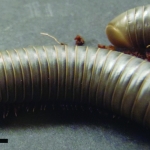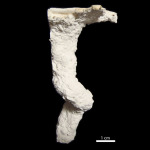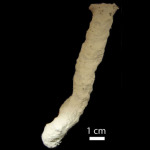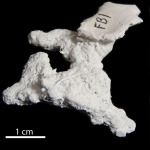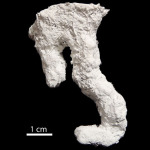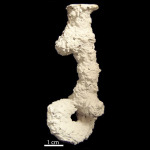Florida Scrub Millipede(Floridobolus penneri)
For full details see Bowen and Hembree (2014) in Palaeontologia Electronica.
Description of Organism
- North American millipede that inhabits xeric, infertile sandy scrubland of south central Florida, USA
- Millipedes have bodies comprised of multiple fused segments (diplosegment), each with two pairs of legs and tracheae
- A calcite-impregnated, chitinous exoskeleton provides physical defense and protection against desiccation
- Full adult length can reach 9 cm
- Lives primarily in burrows with only observed above-surface activity occurring in mid-summer
Published Descriptions of Organism
Bowen and Hembree (2014)
- Floridobolus penneri, the Florida scrub millipede, is a large, North American millipede that reaches an adult length of 9 cm. The species is restricted to xeric, infertile, sandy scrublands in south central Florida. Little has been published regarding the ecology of F. penneri, but it is known to spend a majority of the time in its burrows and is mostly surface active in the mid-summer. Its feeding habits have not been well-studied and are still not well known.
Burrowing Technique
Floridobolus penneri uses a compaction technique similar to Narceus americanus. This technique was only used at the surface, however. In the subsurface, F. penneri uses an excavation technique, first removing sediment grains with their mandibles and then moving them along several diplosegments until they are deposited outside the burrow. The millipede rotates its body as it excavates in order to evenly remove material from all sides of the burrow. This technique is used in all sediment types.
Burrowing Technique Videos
Burrowing Behavior
The millipedes begin to burrow within 30 minutes of their placement in the enclosure. Some initial burrows are abandoned, leaving only a shallow divot in the sediment surface. Burrows are used as temporary shelters to permanent dwellings, with occupation lasting from several hours to over 90 days. Molting also occurred within subsurface chambers. Burrows tend to be 5-35 cm deep. This range of burrow depths occurs even over long periods of occupation. Individuals exit their burrows in the dark to feed. The millipedes frequently exit their burrows backwards, as most burrows lack an area large enough to turn around.
Trace Morphology
Floridobolus penneri produced five distinct burrow architectures: vertical shafts, subvertical ramps, helical burrows, J-, and O-shaped burrows; examples of each are shown below. Modifying features including branches, chambers, and partial spirals. Each photo is linked to an information page about the specific burrow architecture shown.
